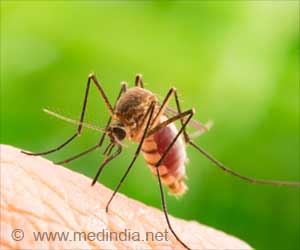French scientists said Monday the Ebola virus can swap genetic material to create new strains, a finding with wide ramifications for attempts to curb this vicious pathogen.
French scientists said Monday the Ebola virus can swap genetic material to create new strains, a finding with wide ramifications for attempts to curb this vicious pathogen.
Until now, there was only one known strain of the so-called Zaire species of Ebola, the most brutal member of the Ebola viral family. It goes by the acronym of ZEBOV.ZEBOV accounts for nearly nine-tenths of all deaths from haemorrhagic fever since Ebola was discovered in 1976 and was notably to blame for a six-week outbreak last September and October in the Democratic Republic of Congo (DRC).
Investigators at France's Institute for Development Research (IRD) said that a probe into an outbreak of Ebola in Gabon and the Republic of Congo had thrown up a new variation of ZEBOV.
Its genome differs from the known lineage of ZEBOV by between two and three percent, and the change can only be explained by recombination, a process in which two viruses exchange genetic material.
Mutation of this kind is well known in the human immunodeficiency virus (HIV) which causes AIDS.
But, the researchers said, it is "much more rare" for recombination to occur among Filoviridiae viruses, the clan to which the four categories of haemorrhagic viruses belong.
It causes the feverish patient to bleed under the skin and in severe cases, from the mouth, ears and eyes. Blood loss, shock and organ failure lead to coma and delirium and, in many cases, to death.
The new variation has been called ZEBOV B to distinguish it from the original strain, which henceforth will be known as ZEBOV A.
A "family tree" of the virus's evolution and a closer look at samples taken from human cases of Ebola suggest that ZEBOV B emerged from a recombination event that took place some time between 1996 and 2001, and was probably to blame for epidemics that struck Gabon and the Republic of Congo between 2001 and 2003.
The IRD team, led by Gabon-based Eric Leroy, said the discovery would shed important light on the dynamics of Ebola epidemics and implied that "some still unknown, much less pathogenic, strains circulate in the wild."
It also had important implications for endeavours to create an Ebola virus.
A typical approach in vaccine research is to use a so-called live attenuated virus -- a virus whose pathogenicity has been dampened -- to induce immune responses against a pathogen.
But this approach would be dangerous in Ebola as the attenuated virus could possibly recombine with a wild virus, creating a new, hybrid virus, the IRD said in a press release.
"The next step is to identify the exact genome location where this genetic material exchange between viral lineages takes place," the IRD said. "In order to do that, the complete genetic mapping of the different viral strains remains to be accomplished."
The IRD study was published online on October 17 by the Proceedings of the National Academy of Sciences (PNAS) in the United States.
An outbreak of Ebola virus in northwestern Republic of Congo killed 5,000 Western gorillas in Congo's Lossi Sanctuary park from 2002 to 2004, a study published last December in the US journal Science said.
The death toll was probably only a "small fraction" of gorillas likely to have been killed by Ebola in the past decade, it said.
Source-AFP
SRM/P
 MEDINDIA
MEDINDIA
 Email
Email








